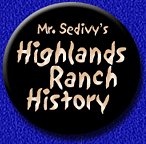|
Highlands Ranch High School - Mr. Sedivy
Highlands Ranch, Colorado

- Colorado History -
The History of Littleton, Colorado
Littleton Trivia:
Stuff You've Always Wondered About
In the City of Littleton
 The Rough and Ready Mill was located at the west end of Main Street.
The Rough and Ready Mill was located at the west end of Main Street.
 The Rough and Ready Mill burned down a total of three times.
The Rough and Ready Mill burned down a total of three times.

Richard Little's Rough and Ready Mill burned down for
the last time in 1959.
 Alamo Street was originally named Malinda Street.
Alamo Street was originally named Malinda Street.
 The street names were attributable to Mr. Little's personal inclination.
Low, Church, and Vermont Streets run east and west to the south of
Main Street, while High and Berry parallel Main Street on its north
side. Intersecting Main Street, running north and south are Rapp,
Curtice, Nevada, and Prince Streets.
The street names were attributable to Mr. Little's personal inclination.
Low, Church, and Vermont Streets run east and west to the south of
Main Street, while High and Berry parallel Main Street on its north
side. Intersecting Main Street, running north and south are Rapp,
Curtice, Nevada, and Prince Streets.
 Curtice Street was named for a close friend of Richard Little's, Rodney
Curtis.
Curtice Street was named for a close friend of Richard Little's, Rodney
Curtis.
 Rapp Street was named for another of Little's friends, Charles Rapp.
Rapp Street was named for another of Little's friends, Charles Rapp.
 Vermont Street recalled Richard Little's eastern home.
Vermont Street recalled Richard Little's eastern home.
 Prince Street was named after Little's favorite horse.
Prince Street was named after Little's favorite horse.
 Richard and Angeline Little had only one child, a son named Lute.
Richard and Angeline Little had only one child, a son named Lute.
 The Lilley family had ten children.
The Lilley family had ten children.
 Alferd Packer, Colorado's infamous cannibal, is buried at the
Littleton Cemetery.
Alferd Packer, Colorado's infamous cannibal, is buried at the
Littleton Cemetery. |
 |
 Laura and Lewis B. Ames were the first two teachers in Littleton.
Laura and Lewis B. Ames were the first two teachers in Littleton.
 Littleton's first school was made of logs and cost $65 to build 1865
- 1866. The restored log school is now on the grounds of the Littleton
Historical Museum.
Littleton's first school was made of logs and cost $65 to build 1865
- 1866. The restored log school is now on the grounds of the Littleton
Historical Museum.
 The 74-mile-long Highline Canal drops 32 inches per mile.
The 74-mile-long Highline Canal drops 32 inches per mile.
 Today's Sterne Lake was originally a pond made by John B. Mayers to
supply ice to Littleton. The ice was moved to the nearby ice house
and covered with sawdust to insulate it for use for the rest of the
year.
Today's Sterne Lake was originally a pond made by John B. Mayers to
supply ice to Littleton. The ice was moved to the nearby ice house
and covered with sawdust to insulate it for use for the rest of the
year.
 The home of Fred Bemis was the first house to be built east of the
railroad tracks.
The home of Fred Bemis was the first house to be built east of the
railroad tracks.

The Home of Fred Bemis in 1889.
 In 1890, Ordinance No. 7 prohibited: "The running at large of horses,
mules, donkeys, cattle, swine, sheep, goats or geese in the Town of
Littleton."
In 1890, Ordinance No. 7 prohibited: "The running at large of horses,
mules, donkeys, cattle, swine, sheep, goats or geese in the Town of
Littleton."
 In the 1890s, the speed limit for trains passing through Littleton
was 15 miles per hour.
In the 1890s, the speed limit for trains passing through Littleton
was 15 miles per hour.
 World War I recruits were trained at Ft. Logan.
World War I recruits were trained at Ft. Logan.
 There was much concern in 1916 regarding chickens running at large
through town.
There was much concern in 1916 regarding chickens running at large
through town.
 Front-wheel drive was invented in Littleton, Colorado by H. R. Holmes
in 1920.
Front-wheel drive was invented in Littleton, Colorado by H. R. Holmes
in 1920.
 The Ku Klux Klan was a strong force in Colorado in the 1920s.
The Ku Klux Klan was a strong force in Colorado in the 1920s.
 Rail-riding hobos often wandered through Littleton in the 1920s and
'30s.
Rail-riding hobos often wandered through Littleton in the 1920s and
'30s.
 In 1940, the population of Littleton was only 2244.
In 1940, the population of Littleton was only 2244.
 In 1942, Denver began buying land south of Littleton's "Pickletown"
to be used as an airport to supplement Stapleton. This land's boundaries
were: Highline Canal on the north, Broadway on the west, County Line
Road on the south, and University Blvd. on the east. (Thankfully,
Denver lost interest in the project!)
In 1942, Denver began buying land south of Littleton's "Pickletown"
to be used as an airport to supplement Stapleton. This land's boundaries
were: Highline Canal on the north, Broadway on the west, County Line
Road on the south, and University Blvd. on the east. (Thankfully,
Denver lost interest in the project!)
 In 1952, Littleton's median income was $2964, slightly less than Arapahoe
County's average of $3095.
In 1952, Littleton's median income was $2964, slightly less than Arapahoe
County's average of $3095.
 Columbine Country Club is located on land once owned by John Lilley.
Columbine Country Club is located on land once owned by John Lilley.
|

John Lilley |
 In French, "Platte" (South Platte River) means "flat."
In French, "Platte" (South Platte River) means "flat."
 The Otoe tribe called the Platte "Ne-Braska" meaning "flat-river."
The Otoe tribe called the Platte "Ne-Braska" meaning "flat-river."
 Bear Creek was called Montana Creek in the 1850s.
Bear Creek was called Montana Creek in the 1850s.
The History of Littleton, Colorado
1. | History
of Littleton: Prehistory - 1859 Colorado Gold Rush |
2. | Littleton in
the Early 1860s / Founding Fathers |
3. | 1860s:
Lewis Ames, Littleton's First Teachers and School,
Indian Troubles and Early Buildings in Littleton |
4. | Littleton
1870 - 1879: Railroads, 1st Church, Highline Canal |
5. | Littleton
in the 1880s: Avery Gallup, First Newspaper |
6. | The
City of Littleton in the 1890s: First Mayor, Pickletown |
7. | 1900s:
South Arapahoe County, Littleton Named County Seat |
8. | Littleton 1910
- 1920s: Town Improvements / Industry |
9. | Littleton, Colorado
in the 1930s and 1940s |
10. | The Boom of
the 1950s and 1960s in Littleton, Colorado |
11. | Littleton:
1970s to Present, Concrete Pods and All |
12. | Littleton Trivia
and Stuff You've Always Wondered About! |
Back to the top of page
- Colorado History In Depth
-
Lecture Notes, Reading, and Information:
| The Cheyenne Migration
to Colorado |
| The Gratlan Affair, Massacre, Fort Laramie
Treaty |
The Cheyenne Social Club
| A Cheyenne War Story: Wolf Road, the Runner
|
| Cheyenne Traditions and Beliefs, Sacred
Stories |
| Horses, Warriors, War Pipe, Sweatlodge
Ceremony |
| Cheyenne War Parties and Battle Tactics
|
| The Scalp Dance and Other Cheyenne Dances
|
Fort Union
| The Sante Fe Trail and Fort Union |
| Sumner - Ninth Military Department / The
First Fort Union |
| Early Arrivals to Fort Union, Daily Life
at Fort Union |
| Captain Grover - The New Fort Union, the
Confederate Threat |
| Fort Union Arsenal, William Shoemaker,
End of Fort Union |
Americans from the East
| Thomas Jefferson, the Louisiana Purchase
|
| The Expedition of Zebulon Pike |
| Pikes Peak or Bust / Colorado Gold Rush
|
Colorado's Role in the US Civil
War
| The Civil War, Fort Wise / Fort Lyon
|
| Mace's Hole, Colonel Canby, F.C.V.R.
| Fort Weld |
| The Pet Lambs, John Chivington |
| General Henry Sibly, Battle of Valverde,
Fort Union |
Cripple Creek District Labor Strikes
| The Western Federation of Miners / State
Militia |
| The 1893 - 1894 Strike | The
Strike of 1903 - 1904 |
| The Mine Owners Association |
| Crimes and Military Rule in the Cripple
Creek District |
| Marshall Law in Cripple Creek District
/ End of the Strike |
Early Cripple Creek District
| Photos, Fire, and Life in Cripple Creek
|
| Other Colorful Towns in the Cripple Creek
District:
Gillett - Colorado's Only Bullfight, Victor, Independence |
| A Guide to the Miners' Gritty Lingo
|
More Colorado History
Information
| Bent's Fort Photos, Personalities, Plans,
and More |
| What Was Easter Like at Bent's Fort?
|
| Colorado Trivia,
Miscellaneous Old Photos,
Western Personalities, Forts, and More |
| Lullabies for Jittery Cows - Cowboy Ballads
|
| Heraldry of the Branding Iron |
| Project
Aims to Clear Infamous Cannibal, Alferd Packer |
| Lead Gives Alferd
Packer's Story More Weight |
| Legendary
Colorado Love Stories: Baby Doe Tabor & More
|
| Colorado Pioneer Women: Elizabeth Byers
|
| Early Denver Jokes / The History of April
Fools' Day |
| History of the US Memorial Day Holiday
|
Back to the top of page
|



![]() 9375 South Cresthill Lane
9375 South Cresthill Lane ![]() Highlands Ranch, Colorado 80126
Highlands Ranch, Colorado 80126 ![]() 303-471-7000
303-471-7000




